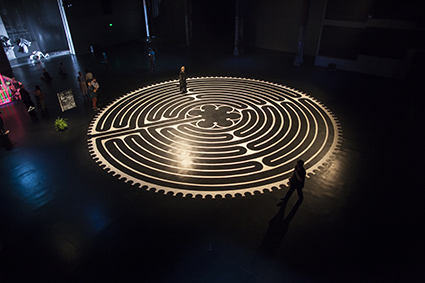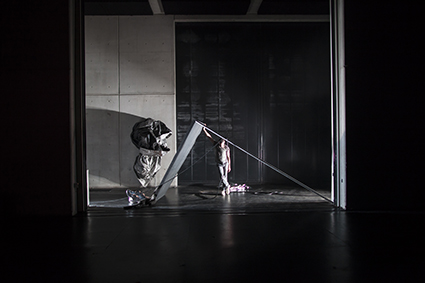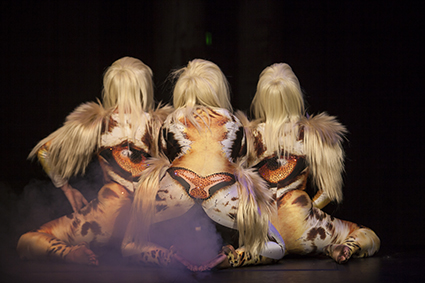Queering the days
Fiona McGregor, Performance Space, Day For Night

Nell, Labyrinth, Day for Night
photo Alex Davies
Nell, Labyrinth, Day for Night
This year’s Day For Night began at night. It was a better format, the Friday night and weekend ensuring a larger, more diverse audience. I spent many hours in the space, and as with last year, found the days a richer experience.
Part of the reason for this was that at the opening party nearly everybody succumbed to Friday-nightis: the wine flowed and flowed and flowed. Consistent with the bacchanalian tradition Day for Night draws upon, this may not matter. With plenty of day-trippers generous with their time and night owls happy to just get down and get out of it, Day for Night is filling its brief. The centrepiece, Nell’s labyrinth, promised to transform into a magical dance-floor but with the speakers up one end near the DJs, on opening night it got lost. During the day, its centrifugal force held. Mesmerising yet understated, it invited participation from young and old, or spectatorship if you arrived at a time when the artist herself was walking it in her painted robe, glacially, eyes barely open, to a soundtrack of a storm by Stereogamous.
Emma Maye Gibson/Betty Grumble and White Drummer
Around the labyrinth were five other performances, Emma Maye Gibson/Betty Grumble and White Drummer occupying diagonal corners for the duration of the event. The anchoring effect of these works was crucial, White Drummer pounding through the space, drowned out intermittently by the shorter performances. Approaching her room, you stood at a window and listened through headphones, the tracks she was playing along to obliterating her drums. Gibson’s post-punk juvenilia—posters, records and cassettes—was scattered around, including little paintings done at age fifteen. A single white bed hid in the far corner. It was a marvellous reconstruction of teenage fantasy, an antidote to girlish innocence—hermetic, claustrophobic, the disjunctions of sound taking us both inside her head and out to the world that had inspired her.
Gibson/Grumble’s petting zoo was a darker realm than the riot of colour suggested. From midday til eight the artist, as Betty Grumble, occupied a jumble of hay bales, costumes and overturned wheelie bin, with brief interludes as a zookeeper. You could sit inside and be petted, and I heard how much anger resided in her trademark clownish make-up and huge hair. A look so surface, it easily repels. The pathos became clearer on the final day when she danced a mad interpretive jazzercise for 10 minutes for the random Sunday crowd. Naked but for make-up, giant wig and penned in g-string, the hybrid of stripper moves and kickboxing seemed more rabid unleashing than rehearsed routine. Men who’d put their cameras up excitedly lowered them disconcertedly. You could hear the slap of flesh, gasping and groaning over the BeeGees “More Than a Woman.”

Matthew Day, (Untitled) Things That Matter, Day for Night
photo Alex Davies
Matthew Day, (Untitled) Things That Matter, Day for Night
Matthew Day
Matthew Day couldn’t have been a greater contrast, performing in white, grey then black. His athletic poses on the podium during the party were like classical statues, in hoodie. I’m sure I saw Rodin’s Thinker, but that may have been the wine. The following day, in a recess beyond the bay, Day was like an Anselm Kiefer come to life, grappling with tarp, chain, rubber hosing, a massive panel and a lead pipe. It was action art, object-based performance such as rarely seen here, though Day’s dance discipline was still the driving force.
Técha Noble
Técha Noble’s Party Body Rewind showed the legacy of her former time with the Kingpins with slick choreography and clever interplay of screened and actual performance. The three dancers’ entrance and movement through the party dancers in a giant black hide tufted with wigs, like a sort of Trojan horse, was a terrific moment. During the day, despite greater visibility, the beast had less impact. The dancers created a trompe l’oeil of a tiger’s face with their costumes, in moves minimal yet fiercely sexual, eventually revealing their faces, snarling and tough, ending with a thrilling, vigorous, African dance hall routine.

Técha Noble, Caroline Garcia, Rachel Melky, Party Body Rewind, Day for Night
photo Alex Davies
Técha Noble, Caroline Garcia, Rachel Melky, Party Body Rewind, Day for Night
Benji Ra
Dance was the strongest element of the event, Benji Ra’s Pioneers giving a local, idiosyncratic rendition of vogueing, dragging it from black America into Asian Australia. The dancers were riveting both as group and solo. At the party, the performance seemed narcissistic, tediously self-conscious with its semi-circle of mirrored screens, the dancers watching themselves, oblivious to us. But the veneer broke when you moved to the sides, the dance becoming both rehearsal and recital, extending to a great display of stamina and skill—the performance of life, its constant rehearsal in the digital age, porous to audience intervention. I hoped someone would enter and dance with them but their command was intense, their installation only infiltrated in their absence.
Children had a great time, as in Nell’s labyrinth. Their heightened responses enlivened the days. Opportunities for kids to access intensely embodied queer culture without fear or compromise are rare: may they continue.
Time, sound, limits
Yet again, the parts of Day for Night did not add up to a satisfying whole. The dance party has got to improve its sound. As I type, Stereogamous are coming out of my laptop more clearly than they did that night. As soon as the room fills, the sound muffles, affecting visuals as well in the clustering of the crowd to hear better. Is the space too big, the expense too great? Are there noise limits? Yet Ryoji Ikeda’s Test Pattern two years ago in an even bigger Bay was cacophonous. And as good as all the individual works were, sometimes even great, it wasn’t risky and edgy as co-curator Jeff Kahn had promised in his opening speech. There was barely a glimmer of politics. Duration, central to the event, did not determine most of the performances. Time was not submitted to. There is still the sense that the curatorial vision is led predominantly by aesthetics, the aim for a refined finish and sealed piece that can punch the clock. That certainly makes it easier to time your entrance to ‘catch the show.’ Instead, why not catch us unawares? Work us harder: we can take it.
Performance Space have a guarantee from Mardi Gras and Carriageworks to go ahead with the event next year. What a tremendous luxury, to cogitate for a whole year on the next curatorial adventure. May the next Day for Night leap the bar.
Day For Night, curators Emma Price, Jeff Khan; presenters Performance Space, Carriageworks, Sydney Gay and Lesbian Mardi Gras; Carriageworks, Sydney 20-22 Feb
RealTime issue #126 April-May 2015 pg. 34






